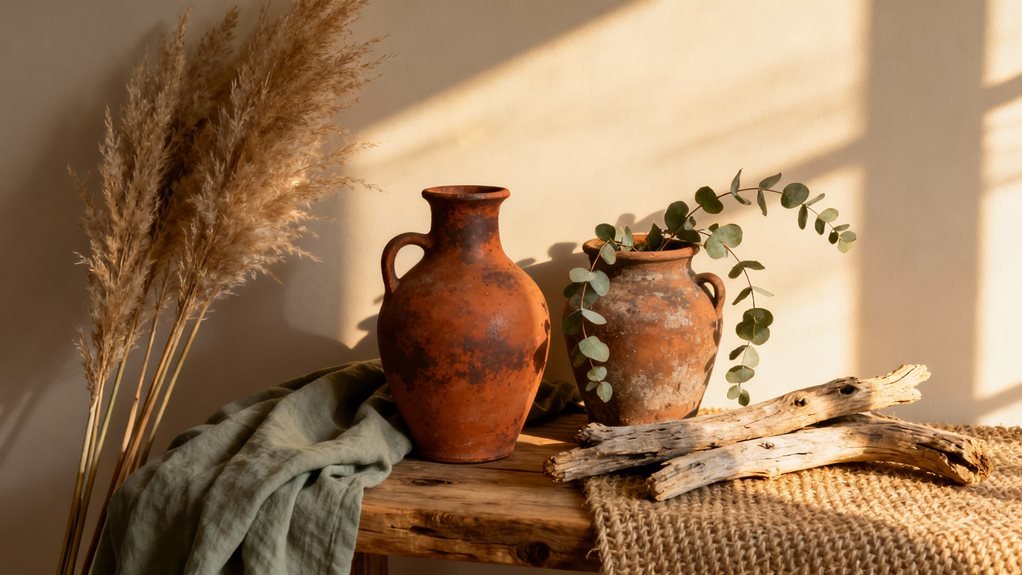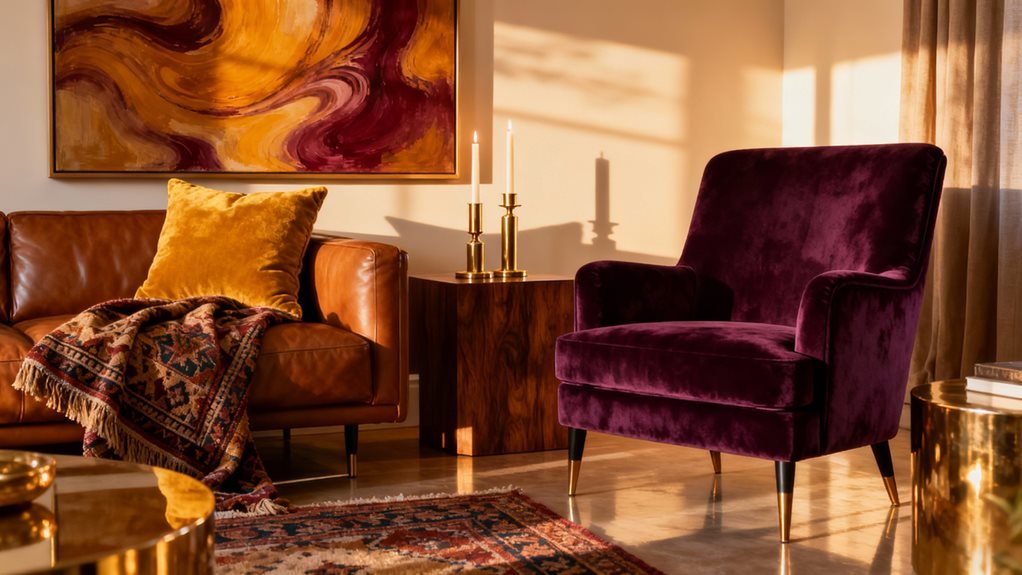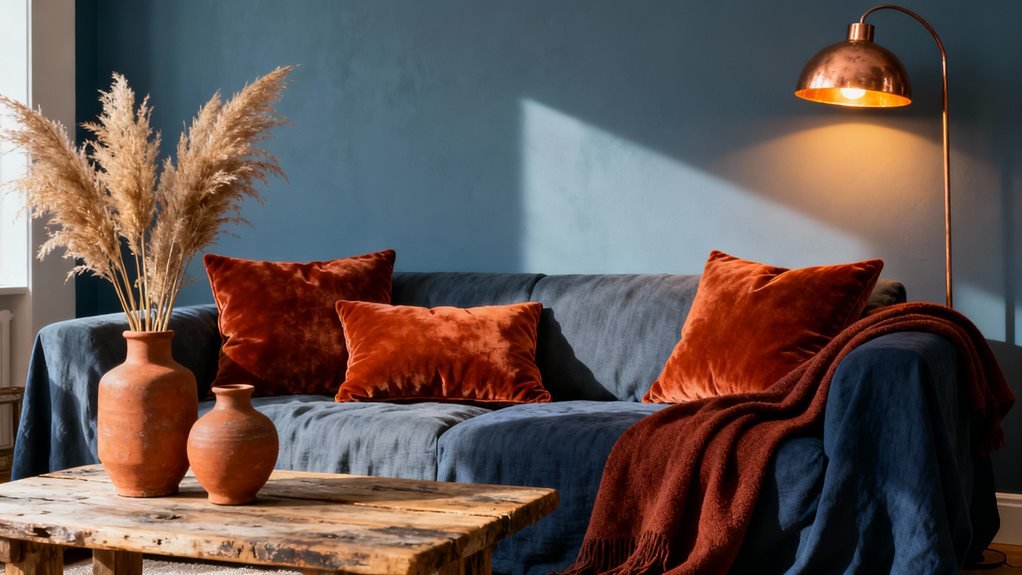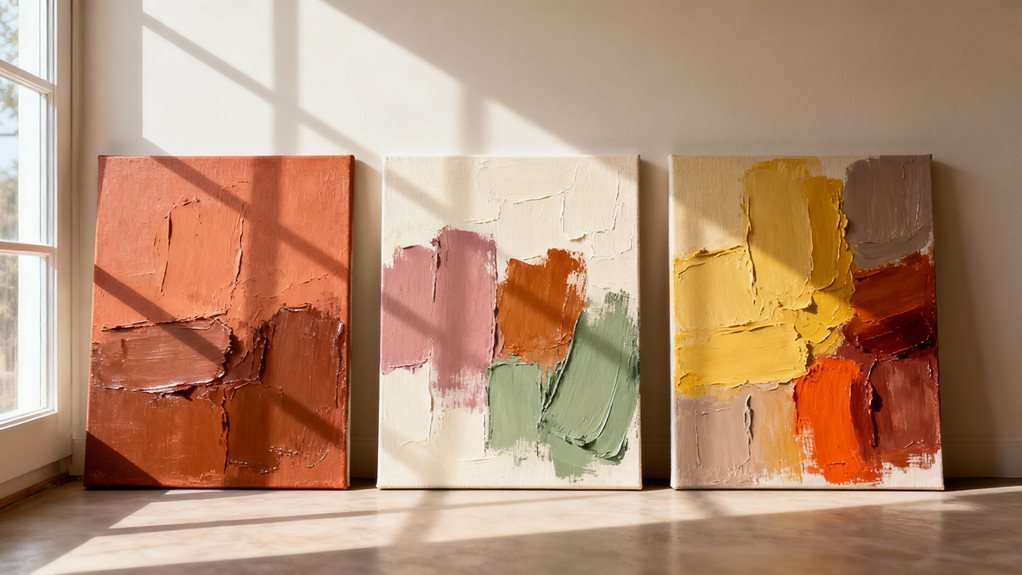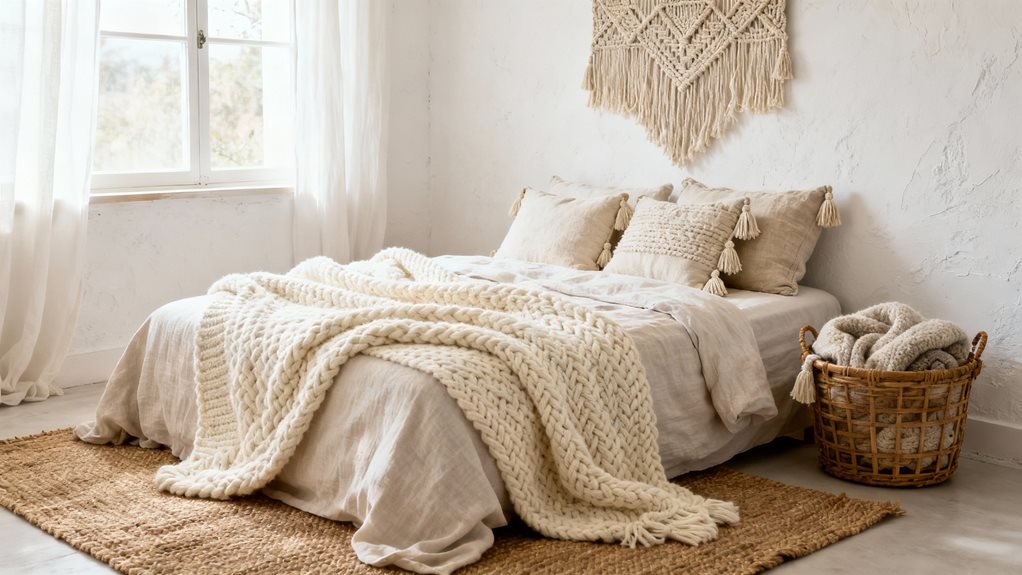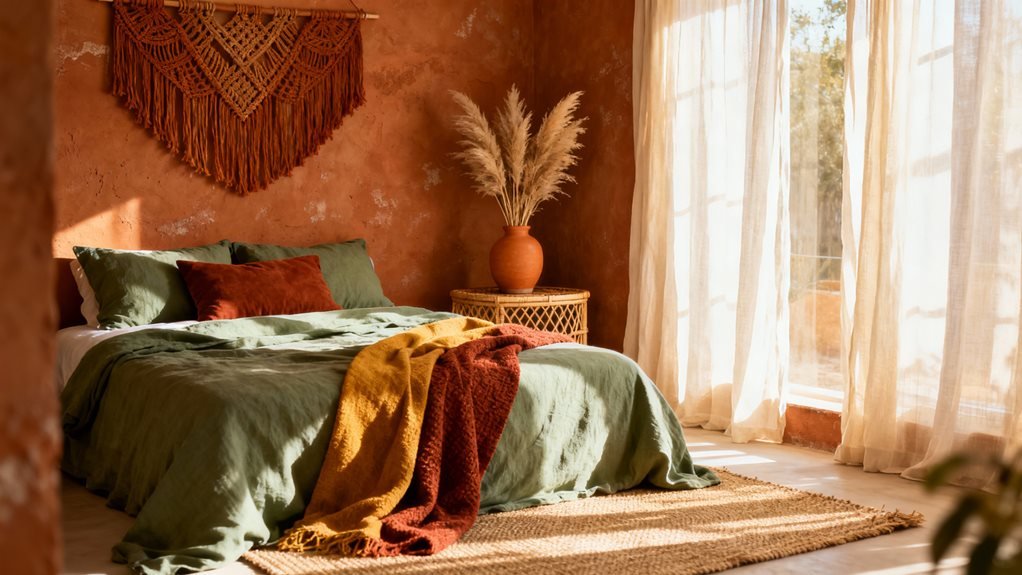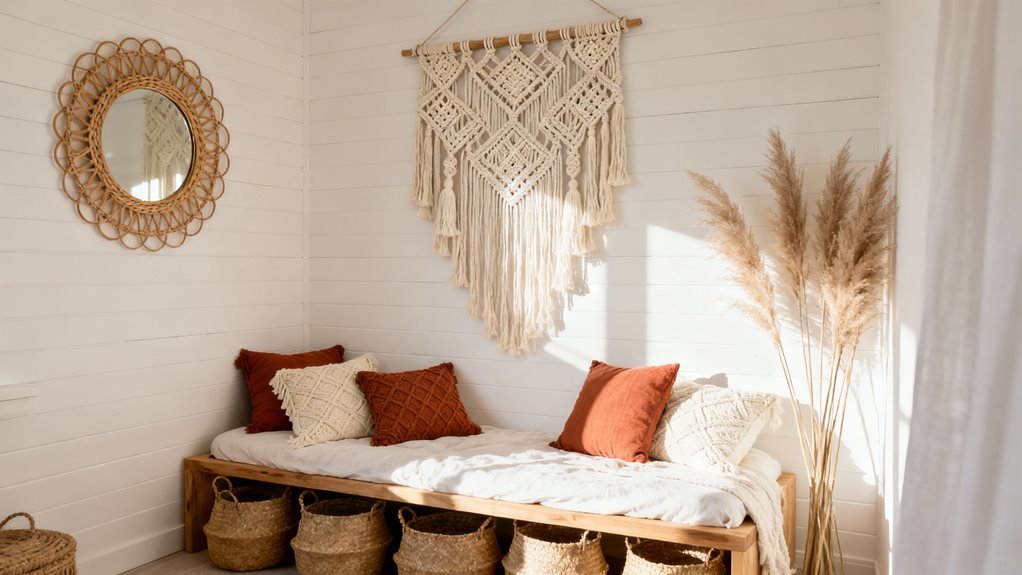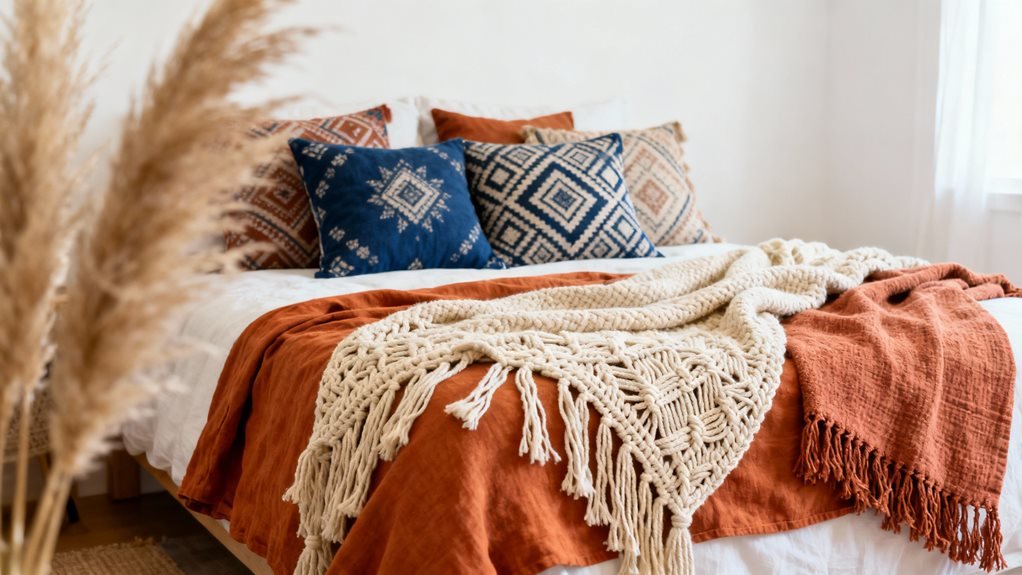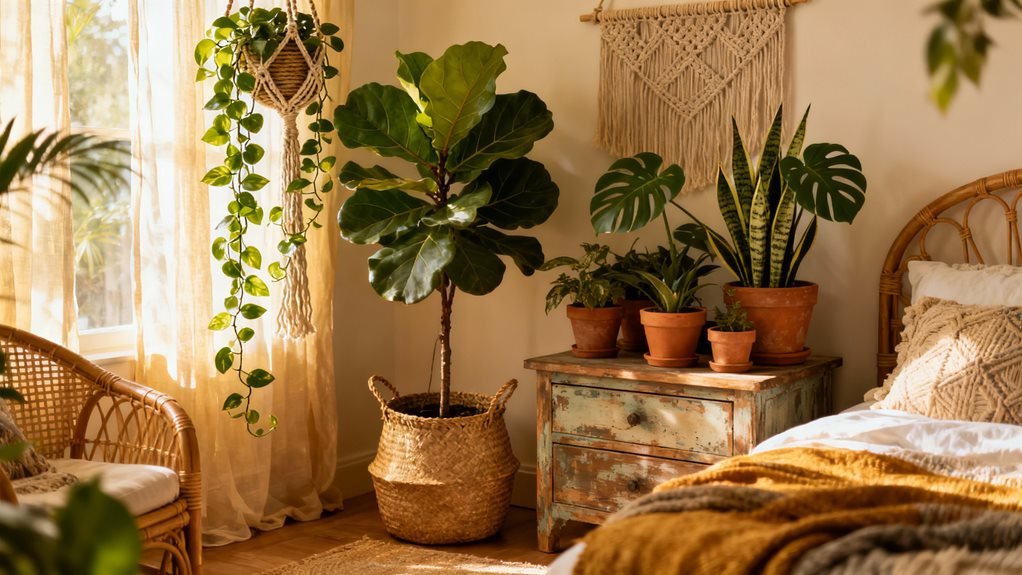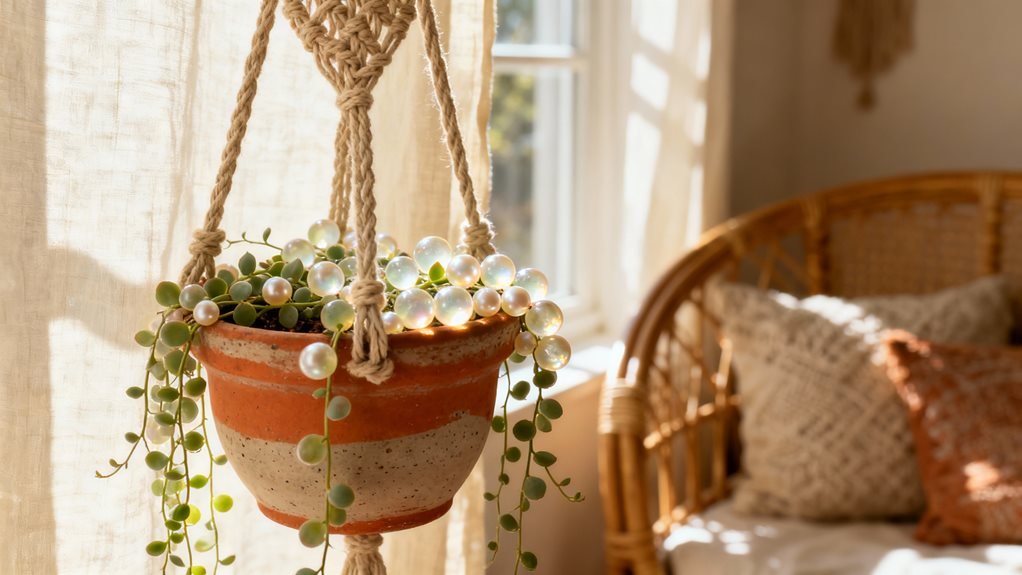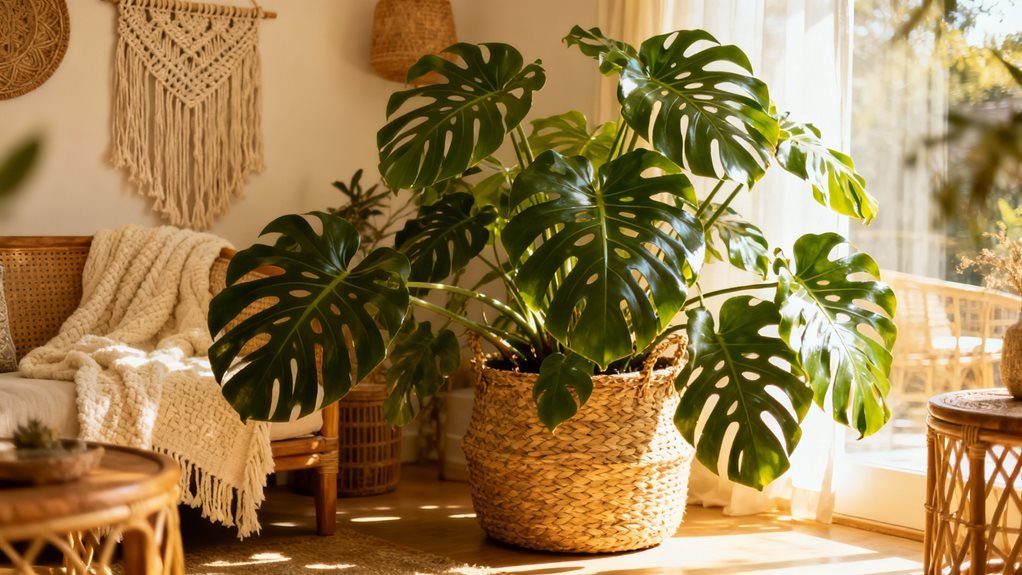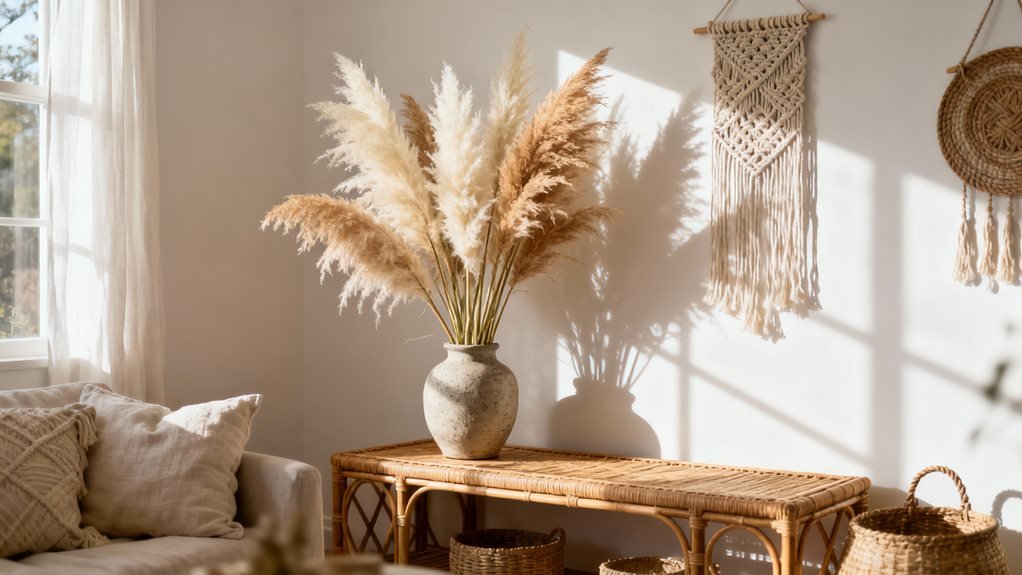I’ve transformed countless bland bedrooms into cozy boho sanctuaries, and it always starts with layering natural textures like chunky knits and macramé. I mix warm terracotta tones with earthy neutrals, then add patterned pillows in varying scales. String lights and lanterns create that dreamy glow, while potted plants breathe life into every corner. I love draping fabric canopies overhead and layering global rugs underfoot. Personal collections and vintage finds make it uniquely yours—and there’s so much more to explore in crafting your perfect retreat.
Design Highlights
- Layer earthy terracotta and rust tones with natural textures like jute rugs and wooden furniture for a warm, cocooned aesthetic.
- Mix three to four fabric types—chunky knits, macramé pillows, velvet cushions—to create tactile interest without overwhelming the space.
- Install soft ambient lighting using string lights, lanterns, and warm-toned bulbs at varying heights to avoid harsh overhead illumination.
- Add low-maintenance greenery like pothos and snake plants at different heights to bring organic life into the room.
- Layer woven decor, vintage mirrors, and personal collections in odd numbers to achieve a collected-over-time, artisan-crafted vibe.
Layer Natural Textures Through Textiles and Fabrics
Start with your foundation: cotton or linen sheets create breathability. Then I add a chunky knit throw at the foot of my bed—it’s both tactile eye candy and functional warmth. Macramé pillows bring that boho vibe while adding dimensional interest.
Here’s what transformed my space: mixing materials instead of matching them. I pair a jute rug with velvet cushions, or drape a woven blanket over rattan furniture. The contrast creates visual richness without overwhelming your senses.
Don’t overthink it. Grab textures that make you want to touch them. I’ve found that three to four different fabric types hits the sweet spot—enough variety to feel luxurious, but not so much that it becomes chaotic. Your bedroom should embrace you, not just house you.
Embrace Earthy and Warm Color Palettes
I’ve found that swapping out cool grays and stark whites for warm terracotta and rust tones instantly makes my bedroom feel like a cozy retreat instead of a sterile hotel room. These earthy hues work beautifully when you start with natural neutral base layers—think warm beiges, soft taupes, and creamy off-whites that ground the space. You’ll be amazed how this simple color shift can transform the entire energy of your room, making it feel more inviting the moment you walk through the door.
Terracotta and Rust Tones
Terracotta and rust tones have this incredible ability to make a bedroom feel instantly cocooned and lived-in—like you’ve wrapped yourself in a favorite worn-in leather jacket. I’ve found these shades work beautifully whether you’re bold enough to paint an accent wall or prefer starting small with terracotta throw pillows and rust-colored blankets.
What I love most is how forgiving these colors are. They hide imperfections while adding depth that cooler tones just can’t match. Try layering different rust shades together—a burnt orange duvet with deeper terracotta cushions creates dimension without feeling busy.
And here’s my favorite trick: pair these warm tones with natural textures like jute rugs or wooden furniture. The combination feels effortlessly earthy and sophisticated simultaneously.
Natural Neutral Base Layers
While those vibrant terracotta moments steal the show, they need something calm to lean against—that’s where natural neutrals become your bedroom’s best friend. I’ve learned that starting with creamy whites, warm beiges, and soft taupes creates the perfect canvas for layering. Think linen bedding in oatmeal, a jute rug underfoot, or those gorgeous rattan accents that add texture without competing for attention.
I always tell people: your base layers shouldn’t bore you—they should ground you. Choose materials that feel organic, like cotton waffle throws or chunky knit blankets in sandy tones. These neutrals let your terracotta pillows pop while keeping everything balanced. When you walk into your space, you’ll feel wrapped in warmth rather than overwhelmed by color.
Incorporate Macramé Wall Hangings and Woven Decor
I’ll never forget the first time I hung a macramé piece above my bed—it instantly softened the entire room and made it feel like a cozy retreat. When you’re choosing your wall hangings, look for pieces that complement your color palette while adding that handcrafted warmth only woven textures can provide. I’ve found the real magic happens when you layer different woven elements throughout the space, from wall art to baskets to throws, creating depth that makes your sanctuary feel thoughtfully curated rather than decorated.
Choosing Macramé Wall Pieces
Have you ever noticed how a bare wall can make even the coziest bedroom feel incomplete? I’ve found that selecting the right macramé piece can instantly transform that empty space into a stunning focal point.
When I’m choosing macramé wall hangings, I consider three key factors. First, I measure my wall space carefully—oversized pieces work beautifully above beds, while smaller designs complement gallery walls. Second, I examine the knot patterns and texture. Intricate designs add drama, whereas simple patterns create subtle elegance. Finally, I match the cord color to my existing palette. Natural cotton provides that authentic boho vibe, while dyed fibers introduce personality.
I’ve learned that investing in handcrafted pieces supports artisans and ensures quality that’ll last years.
Layering Woven Texture Elements
Once you’ve selected your perfect macramé piece, the real magic happens when you start combining it with other woven textures throughout your bedroom. I love mixing different materials—rattan baskets for storage, a jute rug underfoot, and woven lampshades that cast gorgeous shadows. Don’t be afraid to experiment with varying scales either. I’ll place a chunky knit throw across my bed, then balance it with delicate woven coasters on my nightstand. The key is creating depth without overwhelming your space. Start with three different woven elements and build from there. You’ll notice how these natural textures work together to soften harsh lines and add that essential boho warmth. Trust me, this layering approach transforms any bedroom into a cozy sanctuary.
Mix and Match Patterned Pillows and Throws
Why do the coziest bedrooms always look like they’ve been styled by a magazine editor? I’ll let you in on a secret: it’s all about mixing patterns fearlessly. I’ve learned that combining different prints creates that effortless, collected-over-time vibe that makes boho spaces irresistible.
Start by choosing a color palette, then go wild within those boundaries. I typically layer three to five pillows in varying sizes, mixing geometric prints with florals and traditional patterns.
Here’s what works for me:
- Vary your scales: Pair large-scale prints with smaller, intricate patterns to create visual interest without overwhelming the space
- Embrace odd numbers: Three or five pillows look more organic than even groupings
- Layer textures: Combine smooth cotton with chunky knits and velvet for dimension
- Anchor with solids: Use one or two solid-colored pieces to give your eyes a resting spot
The key? Trust your instincts and have fun experimenting.
Add Greenery and Potted Plants Throughout the Space
I’ll never forget the day I brought home my first potted fiddle leaf fig—it honestly felt like my bedroom finally exhaled. Something about living greenery transforms a space from decorated to truly alive.
I’ve learned you don’t need a green thumb to incorporate plants into your boho sanctuary. Start with low-maintenance options like pothos, snake plants, or succulents. I keep a trailing pothos on my dresser and watch it cascade down—it’s become my favorite living art piece.
Mix different heights and textures throughout your room. I’ve placed small succulents on my nightstand, a medium monstera in the corner, and hung a macramé planter near the window. The varying levels create visual interest while purifying the air.
Don’t stress about perfection. Even fake plants work if you’re worried about upkeep. What matters is bringing that organic, earthy element into your space.
Choose Low-Profile Furniture With Natural Wood Tones
After filling my bedroom with living greenery, I noticed something interesting—my chunky, oversized furniture suddenly felt out of place. The delicate plants demanded a lighter touch, so I swapped my bulky pieces for low-profile furniture in natural wood tones. This transformation created the flow I’d been missing.
Low-profile furniture keeps your eye moving horizontally rather than stopping at tall, imposing pieces. I’ve found that natural wood tones—think warm teak, light oak, or rich walnut—complement the organic boho aesthetic perfectly.
Here’s what works beautifully:
- Platform beds with simple frames that sit close to the ground
- Low-slung dressers and nightstands with visible wood grain
- Rattan or wicker storage pieces that add texture without bulk
- Japanese-inspired benches or floor cushions for seating
The effect is calming and intentional. Your bedroom won’t feel crowded anymore—instead, you’ll create breathing room that makes the space feel larger and more serene.
Create Ambient Lighting With String Lights and Lanterns
I’ve learned that harsh overhead lighting can kill the peaceful vibe you’re working so hard to create in your bedroom. That’s why I’m obsessed with layering softer light sources—think string lights draped across your headboard, a lantern on your nightstand, and maybe a floor lamp in the corner. The key is placing these at different heights around the room so you’re wrapping yourself in a warm, gentle glow that actually helps you unwind.
Layering Different Light Sources
Why settle for harsh overhead lighting when you can create a warm, inviting atmosphere with layered light sources? I’ve found that combining multiple lighting types transforms my bedroom into a cozy retreat. The key is mixing different heights and intensities to create depth and dimension.
Here’s what works beautifully:
- Table lamps on nightstands for reading and ambient glow
- Floor lamps in corners to illuminate dark spots
- Candles (real or LED) for flickering warmth
- Himalayan salt lamps for a soft, peachy radiance
I recommend using warm-toned bulbs throughout—they’re game-changers for creating that bohemian vibe. Start with your string lights as a base layer, then add these sources strategically. You’ll notice how each light source plays off the others, creating shadows and highlights that make your space feel genuinely magical.
Placement for Maximum Ambiance
When I first started experimenting with string lights, I draped them randomly across my wall and wondered why they looked more dorm-room than dreamy sanctuary. The secret? Strategic placement makes all the difference.
I’ve found that draping lights along your headboard creates an intimate glow that’s perfect for winding down. You can also weave them through a canopy frame or around mirrors to amplify their warmth. I particularly love placing lanterns at varying heights—one on my nightstand, another on a floating shelf—to create depth and visual interest.
Here’s what works: avoid centering everything. Asymmetrical placement feels organic and bohemian. Place your brightest sources where you need them functionally, then layer softer lights throughout for that coveted ambient effect.
Display Personal Collections and Vintage Finds
How often have you spotted a treasured object tucked away in storage, forgotten until a random spring cleaning day? I’ve learned that those meaningful pieces deserve center stage in your boho bedroom. Your vintage finds and personal collections tell your unique story better than any mass-produced décor ever could.
I encourage you to create intentional displays that spark joy every time you enter your space. That ceramic vase from your grandmother or the seashells you collected on vacation aren’t just objects—they’re memories worth celebrating.
Here’s what I recommend displaying:
- Vintage mirrors with ornate frames layered against walls
- Handwoven baskets clustered at varying heights
- Travel souvenirs arranged on floating shelves
- Antique books stacked with dried flowers on top
Don’t overthink the arrangement. I’ve found that grouping items in odd numbers creates visual interest, while mixing textures and heights adds that effortless boho vibe you’re after.
Install a Statement Canopy or Draped Fabric Above the Bed
Nothing transforms a bedroom quite like the drama of fabric floating above your bed. I’ve installed canopies in three different homes, and each time, I’m amazed at how instantly romantic the space becomes.
You don’t need fancy hardware or expensive materials. I’ve used simple ceiling hooks with flowing cotton muslin, and the effect was stunning. For a more structured look, try a circular hoop suspended from the ceiling with sheer curtains cascading down the sides.
The key is choosing fabric that complements your boho aesthetic. I love natural linen in cream or terracotta, but gauzy white cotton creates that dreamy, ethereal vibe too.
Here’s my trick: layer different textures. Combine sheer fabrics with heavier drapes to add depth and visual interest.
The beauty of a canopy is how it creates an intimate cocoon around your bed, making your sanctuary feel truly special.
Bring in Global-Inspired Rugs and Floor Cushions
While your eyes are drawn upward to that beautiful canopy, the floor beneath your feet deserves just as much attention. I’ve found that layering global-inspired rugs creates an instant bohemian foundation that grounds the entire room. Think vintage Persian runners overlapping with Moroccan boucherouite rugs, or Turkish kilims paired with natural jute.
Floor cushions are my secret weapon for transforming a bedroom into a true sanctuary. They invite you to sit, meditate, or curl up with a book in ways traditional furniture never could.
Consider these elements for your floorscape:
- Layered textures: Mix a flat-weave kilim base with a plush Moroccan wool rug on top
- Poufs and meditation cushions: Scatter Moroccan leather poufs or Indian block-printed floor pillows in corners
- Natural fibers: Incorporate seagrass or jute rugs to balance ornate patterns
- Color coordination: Choose rugs that echo your existing palette while adding visual interest
This approach creates depth and makes your space feel collected over time.
Frequently Asked Questions
How Much Does It Cost to Create a Boho Bedroom on a Budget?
I’ve created stunning boho bedrooms for under $200, while others spend thousands on designer pieces. Here’s my secret: I thrift macramé wall hangings for $10 instead of $80, swap pricey rattan furniture with DIY painted pieces, and layer budget textiles from discount stores. You’ll spend roughly $150-$500 depending on your room size. I’ve learned that boho’s all about textures and patterns, not price tags. Start small with throw pillows and plants—you’ll be amazed at the transformation!
Can Boho Style Work in a Small Bedroom or Studio Apartment?
I’ve actually found that boho style thrives in small spaces. The key is embracing vertical storage with hanging plants and wall-mounted shelves. I recommend using lighter colors to keep things airy, then layering in textures through throw pillows and a cozy rug. Don’t overcrowd—select a few statement pieces like a macramé wall hanging or rattan mirror. Trust me, small bedrooms can feel incredibly cozy and bohemian without looking cluttered!
How Do I Maintain and Clean All the Textiles in a Boho Bedroom?
I’ll admit, the irony of boho’s “carefree vibe” is all the textile maintenance! But I’ve got you covered. I rotate washable items monthly, vacuuming tapestries and rugs weekly with an upholstery attachment. For pillows, I spot-clean immediately and fluff them outdoors in sunshine—it’s naturally antibacterial. I also shake out throws regularly and steam-clean larger pieces seasonally. Trust me, these simple habits keep your bohemian sanctuary fresh without overwhelming you!
Is Boho Style Suitable for Rental Properties Without Damaging Walls?
I’ve styled countless rental bedrooms in boho style without losing a cent of my deposit. I rely on removable Command hooks for macramé wall hangings, freestanding mirrors instead of mounted ones, and tension rods for canopies. You can layer rugs, pile on floor cushions, and use furniture-mounted clip lights instead of drilling holes. I’ve found that tapestries with poster putty work perfectly too. Your landlord won’t even know you redecorated!
I’ve transformed bedrooms in as little as a weekend, though I’d give yourself 2-4 weeks for a complete makeover. You can achieve instant impact with textiles and plants in one day, but I’ve found that collecting unique vintage pieces and layering textures takes time. Don’t rush it! I actually enjoyed hunting for special items over a few weeks—it made my boho space feel more authentic and personal rather than rushed.
